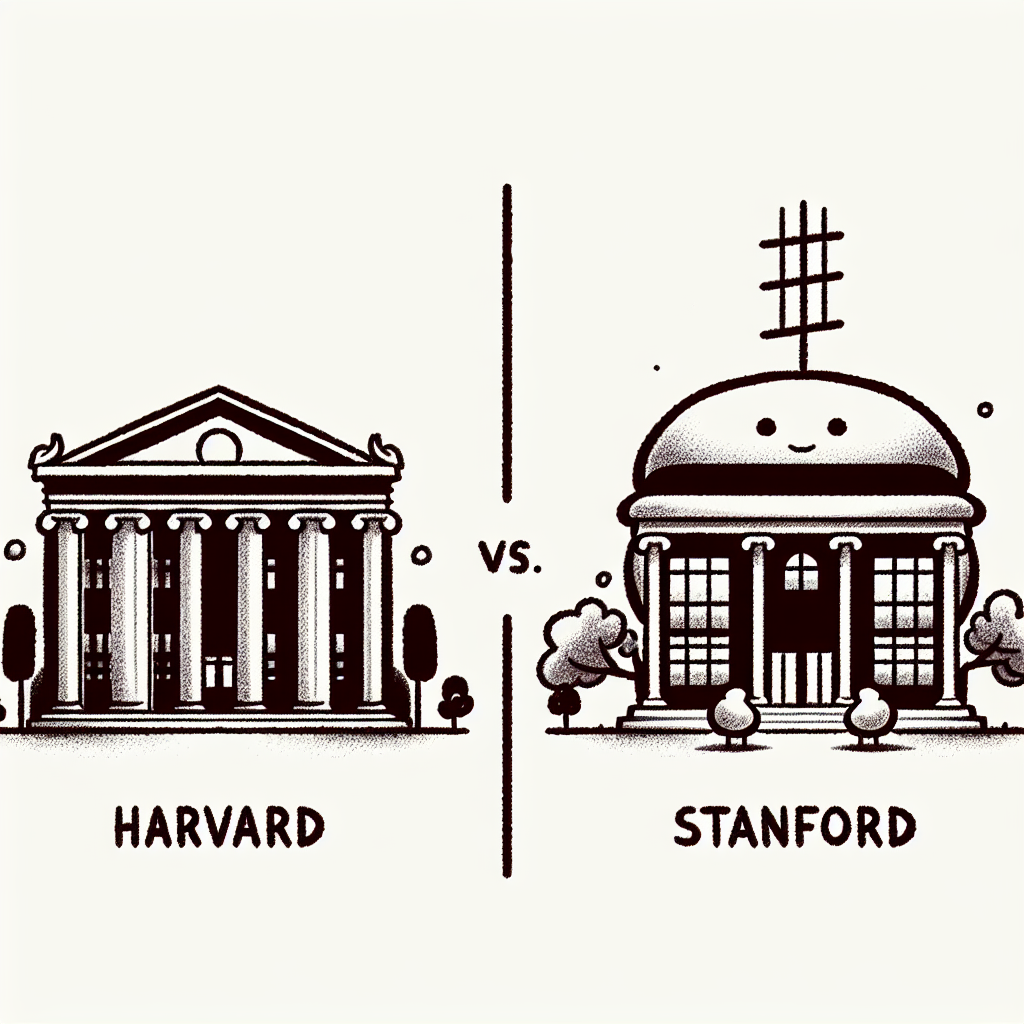Introduction
Harvard University and Stanford University are two of the most prestigious academic institutions in the world. Harvard, founded in 1636 and located in Cambridge, Massachusetts, is the oldest institution of higher education in the United States. It is renowned for its rich history, extensive library system, and influence across fields like law, business, and the humanities. Stanford University, established in 1885 and situated in Stanford, California, has earned a reputation for innovation, particularly in science, engineering, and entrepreneurship, bolstered by its close ties to Silicon Valley.
This comparison of Harvard vs Stanford is designed to help students and families navigate the complexities of choosing between these elite universities. By examining key aspects such as academics, campus culture, financial aid, and career outcomes, this article aims to provide a clear, fact-based perspective that supports informed decision-making.

Admission Landscape
Acceptance Rates
When comparing Harvard vs Stanford, both institutions are among the most selective in the world. Harvard University has an acceptance rate of 3.2%, while Stanford University is slightly higher at 3.7% (collegesimply.com). These ultra-low numbers reflect the intense competition and the high volume of qualified applicants each school receives annually.
Factors Influencing Selectivity
Several factors contribute to the selectivity of Harvard and Stanford. Both universities receive tens of thousands of applications each year, many from students with top academic records, extracurricular achievements, and leadership experience. The strength and size of the application pool are major drivers of low acceptance rates.
Institutional priorities also play a significant role. Each school seeks to build a diverse incoming class aligned with its mission and goals. This includes considerations like geographic diversity, intended major, legacy status, first-generation college status, and athletic recruitment.
Furthermore, both Harvard and Stanford use holistic admissions policies. This means they evaluate each applicant in the context of their background, opportunities, and the full scope of their experiences—not just academic metrics like GPA and test scores.
What the Numbers Mean for Applicants
The low acceptance rates at Harvard and Stanford should be viewed in context. These figures don't necessarily mean an applicant is unqualified, but rather that the competition is extraordinarily stiff. With more qualified applicants than available spots, even strong candidates may not be admitted.
To stand out in such a hyper-competitive environment, applicants should focus on authenticity, depth of involvement, and strong personal narratives. Highlighting unique experiences, demonstrating intellectual curiosity, and showing how they align with the university’s values and community can help an application rise above the rest when choosing between Harvard vs Stanford.

Academic Excellence
When comparing Harvard vs Stanford in terms of academic excellence, both institutions stand out as world leaders, though they differ in certain strengths and characteristics.
Graduation Rates
Graduation rates are a key indicator of student success and institutional support. Harvard has a slightly higher graduation rate at 97%, compared to Stanford's 96% (collegesimply.com). These high rates reflect each university’s commitment to academic support and student achievement.
Student-to-Faculty Ratio
Stanford boasts a lower student-to-faculty ratio of 5:1, compared to Harvard’s 7:1 (collegetuitioncompare.com). This means students at Stanford may experience smaller class sizes and more individualized attention, which can enhance learning and mentorship opportunities.
Academic Strengths and Specialties
Harvard is particularly strong in the humanities, law, political science, and economics. Its long-standing academic tradition and world-renowned faculty make it a powerhouse in these areas. Stanford, on the other hand, excels in STEM fields, entrepreneurship, and technological innovation. Its proximity to Silicon Valley and emphasis on interdisciplinary research contribute to its leadership in science and engineering.
In summary, the comparison of Harvard vs Stanford in academic excellence shows that while both schools offer exceptional education, they cater to different academic interests and learning environments.

Financial Considerations
Tuition and Cost of Attendance
When comparing Harvard vs Stanford, tuition is a key factor. Stanford University has an annual tuition of $65,910, while Harvard University’s tuition is slightly lower at $61,676 (collegetuitioncompare.com). While this difference may seem minor, it can add up over four years of study.
Financial Aid and Affordability
Both Harvard and Stanford offer need-blind admissions for domestic applicants and commit to meeting 100% of demonstrated financial need. This means that a student’s ability to pay does not impact their admission decision, and both institutions provide aid packages that aim to make education affordable regardless of family income.
In terms of average net cost, Harvard often ranks as slightly more affordable due to its extensive endowment and aid resources. For many students, especially those from families earning under $75,000 per year, Harvard may offer a lower out-of-pocket cost. Stanford also provides generous financial aid, but students may see slight differences in aid amounts depending on individual circumstances.
Overall, when considering Harvard vs Stanford from a financial perspective, both schools make strong efforts to ensure affordability, but Harvard may have a slight edge in terms of average net cost.

Career Outcomes
When comparing Harvard vs Stanford in terms of career outcomes, both institutions offer strong post-graduation prospects, but there are notable differences.
Median Earnings 10 Years After Graduation
According to collegesimply.com, the median earnings for Harvard graduates 10 years after graduation is $136,700, while Stanford graduates report a median of $122,900. This suggests a higher average income for Harvard alumni in the long term.
Both universities boast extensive alumni networks that play a significant role in career development. Harvard's alumni network is one of the largest and most influential globally, offering access to a wide range of industries and leadership positions. Stanford, while smaller, has a strong presence in Silicon Valley and the tech industry, providing valuable connections for students pursuing technology or startup careers.
Career services at both schools are robust. Harvard offers diverse career planning resources, employer engagement opportunities, and global internship programs. Stanford emphasizes innovation and entrepreneurship, offering support through its Career Education center and close ties to venture capital networks.
In terms of long-term return on investment (ROI), both institutions rank highly, but Harvard’s slightly higher median earnings may indicate a marginal edge in financial outcomes over time. However, individual career paths and industry choices can significantly influence ROI, making both Harvard and Stanford strong contenders for students prioritizing career outcomes.

Campus Life & Culture
Location and Campus Environment
When comparing Harvard vs Stanford, the campus settings reflect distinct regional influences. Harvard is located in Cambridge, Massachusetts, an urban environment steeped in East Coast academic tradition. The campus is integrated with the city, providing students with immediate access to cultural institutions, historical landmarks, and public transportation. In contrast, Stanford is situated in a sprawling suburban area of Palo Alto, California. Its campus is one of the largest in the country and is heavily influenced by Silicon Valley's innovation-driven atmosphere. This location fosters strong ties to the tech industry and offers a distinctly West Coast lifestyle.
Student Experience
Harvard and Stanford both provide robust residential systems and top-tier campus facilities. Harvard utilizes a house system where upperclassmen live in one of twelve residential houses, fostering tight-knit communities and academic support. Stanford offers a variety of housing options, including themed dorms and cooperative houses, with a strong emphasis on residential education.
Extracurricular life is vibrant at both institutions. Harvard boasts hundreds of student organizations ranging from performing arts to public service, while Stanford is known for its entrepreneurial clubs and tech-focused initiatives. Athletics are integral to student life at both schools. Harvard competes in the Ivy League and has a traditional sports culture, while Stanford is part of the Pac-12 Conference and has a reputation for athletic excellence across many sports.
Social life varies, with Harvard offering a mix of college traditions and urban nightlife, and Stanford emphasizing outdoor activities and student-run events reflective of its California setting.
Diversity and Inclusion
In the discussion of Harvard vs Stanford, both universities prioritize diversity and inclusion through a range of programs and policies. Harvard’s student body is racially and ethnically diverse, with approximately 15% African American, 25% Asian American, and 12% Hispanic or Latino students. Stanford's demographics are similarly diverse, with around 23% Asian, 17% Hispanic or Latino, and 7% Black or African American students.
Both institutions have offices dedicated to equity and inclusion, such as Harvard’s Office for Equity, Diversity, Inclusion, and Belonging and Stanford’s IDEAL (Inclusion, Diversity, Equity, and Access in a Learning Environment) initiative. These programs support underrepresented students, provide cultural centers, and promote campus-wide dialogue on social justice and inclusion.

Research and Innovation
When comparing Harvard vs Stanford in terms of research and innovation, both universities stand at the forefront globally, but they differ in approach, scale, and focus areas.
Funding Levels and Research Output
Stanford consistently ranks among the top universities in the U.S. for research funding, especially in engineering, computer science, and biotechnology. In 2022, Stanford reported over $1.8 billion in research expenditures. Harvard, known for its breadth across disciplines, reported approximately $1.2 billion in research spending the same year, heavily concentrated in medicine, public health, and the social sciences.
In terms of research output, both universities contribute significantly to academic literature, patents, and startup ventures. According to the National Science Foundation, they are among the top institutions for producing high-impact publications and securing federal research grants.
Notable Research Centers and Breakthroughs
Stanford houses leading research centers such as the SLAC National Accelerator Laboratory and the Stanford Artificial Intelligence Laboratory (SAIL), where breakthroughs in particle physics and AI technologies have originated. The university is also closely tied to Silicon Valley, fostering a strong entrepreneurial and tech innovation culture.
Harvard features world-renowned facilities like the Wyss Institute for Biologically Inspired Engineering and the Broad Institute (in collaboration with MIT). Harvard researchers have been instrumental in advancements in CRISPR gene-editing technology and public health strategies, especially during the COVID-19 pandemic.
Undergraduate Research Opportunities
Undergraduate students at both universities have access to robust research opportunities. At Stanford, the Undergraduate Research Student Grants (URS) program funds student-led projects across disciplines. Harvard’s Office of Undergraduate Research and Fellowships provides similar support, including the Harvard College Research Program (HCRP), which funds student research during the academic year and summer.
In evaluating research and innovation, the Harvard vs Stanford comparison reveals two powerhouses with different strengths: Stanford leans more toward technological and entrepreneurial innovation, while Harvard excels in biomedical and social science research.

Global Reputation and Influence
When comparing Harvard vs Stanford in terms of global reputation and influence, both universities consistently rank among the top institutions worldwide. Harvard frequently holds the top spot in global university rankings such as the QS World University Rankings and the Times Higher Education World University Rankings, reflecting its long-standing academic prestige. Stanford often follows closely behind, recognized for its innovation, research output, and entrepreneurial ecosystem.
Harvard’s global reach is reinforced by its extensive network of international partnerships and research collaborations. Its alumni include numerous global leaders, Nobel laureates, and influential academics who contribute significantly to international policy and scholarship.
Stanford, while younger, has developed a powerful global presence through its close ties to Silicon Valley. Its alumni have founded or led many of the world’s most impactful technology companies, giving the university a unique influence on global innovation and digital culture. Stanford also engages in collaborative projects with universities and research institutions across the globe, particularly in science, engineering, and business.
In terms of global alumni impact, Harvard’s network spans centuries and includes heads of state, Supreme Court justices, and prominent scholars. Stanford’s alumni, though more concentrated in the tech and business sectors, have had a profound effect on modern industry and entrepreneurship.
Both Harvard and Stanford demonstrate exceptional global influence, but they do so through different channels—Harvard through traditional academic prestige and leadership, and Stanford through innovation and industry disruption.

Conclusion
When comparing Harvard vs Stanford, several key differences and similarities emerge. Both institutions offer world-class academics, renowned faculty, and strong alumni networks. However, Harvard leans more toward tradition, with its historical roots and emphasis on the liberal arts, while Stanford is known for its innovation and close ties to Silicon Valley.
In terms of campus culture, Harvard tends to be more formal and East Coast-oriented, whereas Stanford fosters a more laid-back, entrepreneurial West Coast environment. Academically, both universities provide rigorous programs, but Stanford often emphasizes STEM and tech-driven disciplines, while Harvard maintains strength across a broader range of fields.
Ultimately, choosing between Harvard and Stanford depends on individual priorities and goals. Students who value historical prestige, a traditional college experience, and a strong presence in politics and law may gravitate toward Harvard. Those drawn to innovation, startup culture, and a dynamic tech ecosystem might find Stanford a better fit. Understanding these differences can help applicants make an informed decision aligned with their aspirations.














